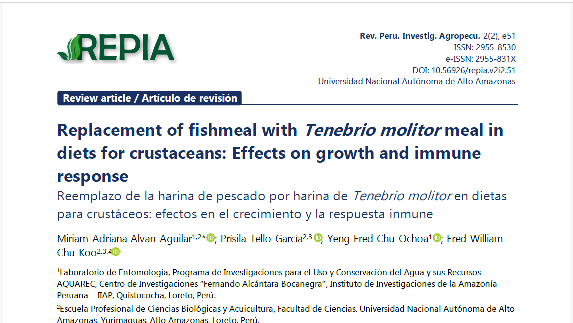Replacement of fishmeal with Tenebrio molitor meal in diets for crustaceans: Effects on growth and immune response
DOI:
https://doi.org/10.56926/repia.v2i2.51Keywords:
aquaculture, feeding, insects, crustacean, healthAbstract
The use of fishmeal (FM) as a protein source in aquaculture is one of the main criticisms of this industry. Increasing production more sustainably is a current imperative for this sector. On the other hand, insect farming has become a promising alternative for aquafeeds, since several species can be produced using organic waste. Insects are organisms rich in nutrients, they contain high amounts of energy, and they have a balanced amino acid profile, unlike protein sources of plant origin that are generally deficient in certain essential amino acids. The objective of the manuscript is to present a review of recent research on the replacement of FM by Tenebrio molitor larvae meal (TMM), a beetle that has become popular as an alternative in aquaculture diets, and its effects on crustaceans’ growth and immune response. Studies indicate that TMM can completely substitute FM in Litopenaeus vannamei, while the substitution levels that worked best for Macrobrachium rosenbergii and crayfish range from 12 to 50%. No studies were found in Amazonian crustaceans or even in South American freshwater prawns, which opens a window of opportunities for the development of new lines of research.
Downloads
References
Choi, I. H.; Kim, J. M.; Kim, N. J.; Kim, J. D.; Park, C.; Park, J. H.; & Chung, T. H. (2018). Replacing fish meal by mealworm (Tenebrio molitor) on the growth performance and immunologic responses of white shrimp (Litopenaeus vannamei). Acta Scientiarum - Animal Sciences, 40, 1–9. https://doi.org/10.4025/actascianimsci.v40i1.39077
Costa-Pierce, B.A.; & Chopin, T. (2021). The hype, fantasies, and realities of aquaculture development globally and its new geographies. World Aquaculture Magazine, 52: 23-35.
Dawood, M.A. (2021). Nutritional immunity of fish intestines: important insights for sustainable aquaculture. Reviews in Aquaculture, 13(1):642e63. https://doi.org/10.1111/raq.12492.
Feng, P.; He, J.; Huang, G.; Chen, X.; Yang, Q.; Wang, J.; Wang, D.; & Ma, H. (2019). Effect of dietary Tenebrio molitor protein on growth performance and immunological parameters in Macrobrachium rosenbergii. Aquaculture, 511, 734247. https://doi.org/10.1016/j.aquaculture.2019.734247
Food and Agriculture Organization of the United Nations – FAO (2021). Fishery and Aquaculture Statistics. Global aquaculture production 1950-2019 (FishstatJ). FAO, Rome, Italy. Available at: www.fao.org/fishery/statistics/software/fishstatj/en
Gasco, L.; Henry, M.; Piccolo, G.; Marono, S.; Gai, F.; Renna, M.; Lussiana, C.; Antonopoulou, E.; Mola, P.; & Chatzifotis, S. (2016). Tenebrio molitor meal in diets for European sea bass (Dicentrarchus labrax L.) juveniles: Growth performance, whole body composition and in vivo apparent digestibility. Animal Feed Science and Technology, 220, 34–45. https://doi.org/10.1016/j.anifeedsci.2016.07.003
Gu, J., Liang, H., Ge, X., Xia, D., Pan, L., Mi, H., & Ren, M. (2022). A study of the potential effect of yellow mealworm (Tenebrio molitor) substitution for fish meal on growth, immune and antioxidant capacity in juvenile largemouth bass (Micropterus salmoides). Fish and Shellfish Immunology, 120(October 2021), 214–221. https://doi.org/10.1016/j.fsi.2021.11.024
Henry, M.A.; Gai, F.; Enes, P.; Pérez-Jiménez, A.; & Gasco, L. (2018). Effect of partial dietary replacement of fishmeal by yellow mealworm (Tenebrio molitor) larvae meal on the innate immune response and intestinal antioxidant enzymes of rainbow trout (Oncorhynchus mykiss). Fish and Shellfish Immunology, 8: 83:30. 8e13. https://doi.org/10.1016/j.fsi.2018.09.040.
Hoffmann, L.; Rawski, M.; Nogales-Mérida, S.; Kołodziejski, P.; Pruszyńska-Oszmałek, E.; & Mazurkiewicz, J. (2021). Mealworm meal use in sea trout (Salmo trutta m. trutta, L.) fingerling diets: effects on growth performance, histomorphology of the gastrointestinal tract and blood parameters. Aquaculture Nutrition, 27(5), 1512–1528. https://doi.org/10.1111/anu.13293
Iaconisi, V.; Bonelli, A.; Pupino, R.; Gai, F.; & Parisi, G. (2018). Mealworm as dietary protein source for rainbow trout: Body and fillet quality traits. Aquaculture, 484: 197–204. https://doi.org/10.1016/j.aquaculture.2017.11.034
Iaconisi, V.; Marono, S.; Parisi, G.; Gasco, L.; Genovese, L.; Maricchiolo, G.; Bovera, F.; & Piccolo, G. (2017). Dietary inclusion of Tenebrio molitor larvae meal: Effects on growth performance and final quality treats of blackspot sea bream (Pagellus bogaraveo). Aquaculture, 476: 49–58. https://doi.org/10.1016/j.aquaculture.2017.04.007
Ido, A.; Hashizume, A.; Ohta, T.; Takahashi, T.; Miura, C.; & Miura, T. (2019). Replacement of fish meal by defatted yellow mealworm (Tenebrio molitor) larvae in the diet improves growth performance and disease resistance in red seabream (Pargus major). Animals, 9(3):100. https://doi.org/10.3390/ani9030100.
Jeong, S. M.; Khosravi, S.; Mauliasari, I. R.; & Lee, S. M. (2020). Dietary inclusion of mealworm (Tenebrio molitor) meal as an alternative protein source in practical diets for rainbow trout (Oncorhynchus mykiss) fry. Fisheries and Aquatic Sciences, 23(1): 214–221. https://doi.org/10.1186/s41240-020-00158-7
Li, X.Y.; Chen, Y.K.; Zheng, C.Z.; Chi, S.Y.; Zhang, S.; Tan, B.P.; & Xie, S.W. (2022). Evaluation of six novel protein sources on apparent digestibility in Pacific White Shrimp, Litopenaeus vannamei. Aquaculture Nutrition. https://doi.org/10.1155/2022/8225273.
Makkar, H.P.S.; Tran, G.; Heuzé, V.; & Ankers, P. (2014). State-of-the-art on use of insects as animal feed. Animal Feed Science and Technology, 197: 1-33. https://doi.org/10.1016/j.anifeedsci.2014.07.008
Mastoraki, M.; Vlahos, N.; Patsea, E.; Chatzifotis, S.; Mente, E.; & Antonopoulou, E. (2020). The effect of insect meal as a feed ingredient on survival, growth, and metabolic and antioxidant response of juvenile prawn Palaemon adspersus (Rathke, 1837). Aquaculture Research, 51: 3551-3562. https://doi.org/10.1111/are.14692
Mazlum, Y.; Turan, F.; & Bircan, Y. (2021). Evaluation of mealworms (Tenebrio molitor) meal as an alternative protein source for narrow-clawed crayfish (Pontastacus leptodactylus) juveniles. Aquaculture Research. 1–9. https://doi.org/10.1111/are.15253
Melenchón, F.; Larrán, A. M.; de Mercado, E.; Hidalgo, M. C.; Cardenete, G.; Barroso, F. G.; Fabrikov, D.; Lourenço, H. M.; Pessoa, M. F.; & Tomás-Almenar, C. (2021). Potential use of black soldier fly (Hermetia illucens) and mealworm (Tenebrio molitor) insectmeals in diets for rainbow trout (Oncorhynchus mykiss). Aquaculture Nutrition, 27(2): 491–505. https://doi.org/10.1111/ANU.13201
Naylor, R.L.; Hardy, R.W.; Buschmann, A.H.; Bush, S.R.; Cao, L.; Klinger, D.H.; Little, D.C.; Lubchenco, J.; Shumway, S.E.; & Troell, M. (2021). A 20-year retrospective review of global aquaculture. Nature, 591: 551-563. https://doi.org/10.1038/s41586-021-03308-6
Panini, R. L.; Freitas, L. E. L.; Guimarães, A. M.; Rios, C.; da Silva, M. F. O.; Vieira, F. N.; Fracalossi, D. M.; Samuels, R. I.; Prudêncio, E. S.; Silva, C. P.; & Amboni, R. D. M. C. (2017). Potential use of mealworms as an alternative protein source for Pacific white shrimp: Digestibility and performance. Aquaculture, 473: 115–120. https://doi.org/10.1016/j.aquaculture.2017.02.008
Rema, P.; Saravanan, S.; Armenjon, B.; Motte, C.; & Dias, J. (2019). Graded incorporation of defatted yellow mealworm (Tenebrio molitor) in rainbow trout (Oncorhynchus mykiss) diet improves growth performance and nutrient retention. Animals, 9(4). https://doi.org/10.3390/ani9040187
Ríos, C.; Panini, R.L.; Acordi Menezes, L.A.; Vieira, F.N.; Fracalossi, D.M.; Samuels, R.I.; De Dea Lindner, J.; & Silva, C.P. (2021). Effects of the substitution of fishmeal with mealworm meal on enzymes, haemolymph and intestinal microbiota of the Pacific white shrimp. Journal of Insects as Food and Feed, 7(6): 1023–1033. https://doi.org/10.3920/JIFF2020.0148
Roncarati, A.; Gasco, L.; Parisi, G.; & Terova, A. (2015). Growth performance of common catchfish (Ameiurus melas Raf.) fingerlings fed mealworm (Tenebrio molitor) diet. Journal of Insects as Food and Feed, 1(3): 233 - 240. https://doi.org/10.3920/JIFF2014.0006
Röthig, T.; Vilcinskas, A.; Barth, A.; Tschirner, M.; Schubert, P.; Wenning, M.; Billion, A.; & Wilke, T. (2023). Insect feed in sustainable crustacean aquaculture. Journal of Insects as Food and Feed, 9(9): 1115-1138. https://doi.org/10.3920/JIFF2022.0117
Sankian, Z.; Khosravi, S.; Kim, Y. O.; & Lee, S. M. (2018). Effects of dietary inclusion of yellow mealworm (Tenebrio molitor) meal on growth performance, feed utilization, body composition, plasma biochemical indices, selected immune parameters and antioxidant enzyme activities of mandarin fish (Siniperca scherze). Aquaculture, 496: 79–87. https://doi.org/10.1016/j.aquaculture.2018.07.012
Shafique, L.; Abdel-Latif, H.M.R.; Hassan, F.-u.; Alagawany, M.; Naiel, M.A.E.; Dawood, M.A.O.; Yilmaz, S.; & Liu, Q. (2021). The feasibility of using Yellow Mealworms (Tenebrio molitor): Towards a sustainable aquafeed industry. Animals, 11, 811. https://doi.org/10.3390/ani11030811
Sharifinia, M.; Hossein, K.M.; Afshari, B.Z.; Keshavarzifard, M.; Daliri, M.; Koochaknejad, E.; & Sedigh, J.M. (2023). Fishmeal replacement by mealworm (Tenebrio molitor) in diet of farmed Pacific white shrimp (Litopenaeus vannamei): effects on growth performance, serum biochemistry, and immune response. Aquatic Living Resources, 36, 19. https://doi.org/10.1051/alr/2023013
Shin, J.; & Lee, K-J. (2021). Digestibility of insect meals for Pacific white shrimp (Litopenaeus vannamei) and their performance for growth, feed utilization and immune responses. PLoS ONE, 16(11): e0260305. https://doi.org/10.1371/journal.pone.0260305
Smetana, S.; Schmitt, E.; & Mathys, A. (2019). Sustainable use of Hermetia illucens insect biomass for feed and food: Attributional and consequential life cycle assessment. Resources, Conservation and Recycling, 144: 285-296. https://doi.org/10.1016/j.resconrec.2019.01.042
Su, J.; Gong, Y.; Cao, S.; Lu, F.; Han, D.; Liu, H.; Jin, J.; Yang, Y.; Zhu, X.; & Xie, S. (2017). Effects of dietary Tenebrio molitor meal on the growth performance, immune response, and disease resistance of yellow catfish (Pelteobagrus fulvidraco). Fish and Shellfish Immunology, 69: 59–66. https://doi.org/10.1016/j.fsi.2017.08.008
Tacon, A.G.J. (2020). Trends in global aquaculture and aquafeed production: 2000-2017. Reviews in Fisheries Science and Aquaculture, 28: 43-56. https://doi.org/10.1080/23308249.2019.1649634
Wang, T.; Wang, X.; Shehata, A.I.; Wang, R.; Yang, H.; Wang, Y.; Wang, J.; & Zhan, Z. (2022). Growth performance, physiological and antioxidant capacity responses to dietary fish meal replacement with insect meals for aquaculture: A case study in red claw crayfish (Cherax quadricarinatus). Aquaculture Research, 53(10): 3853-3864. https://doi.org/10.1111/are.15892
Zheng, Y.; Hou, C.; Chen, J.; Wang, H.; Yuan, H.; Hu, J.; Shi, L.; & Zhang, S. (2023). Integrating microbiome and transcriptome analyses to understand the effect of replacing fishmeal with Tenebrio molitor meal in Pacific white shrimp (Litopenaeus vannamei) diets. Aquaculture, 575, 739818. https://doi.org/10.1016/j.aquaculture.2023.739818.

Published
How to Cite
Issue
Section
License
Copyright (c) 2023 Miriam Adriana Alvan-Aguilar, Prísila Tello-García, Yeng Fred Chu-Ochoa, Fred William Chu-Koo

This work is licensed under a Creative Commons Attribution 4.0 International License.
Authors retain their rights:
a. The authors retain the intellectual property rights (copyright) of the published works, assigning to the journal the right of first publication.
b. Authors retain their trademark and patent rights, and also on any process or procedure described in the article.
c. Authors retain the right to share, copy, distribute, perform and publicly communicate the article published in REPIA (e.g., place it in an institutional repository or publish it in a book), with an acknowledgement of its initial publication in REPIA.
d. Authors retain the right to make a subsequent publication of their work, to use the article or any part of it (e.g., a compilation of their work, notes for conferences, theses, or for a book), provided they indicate the source of publication (authors of the work, journal, volume, number, and date).







